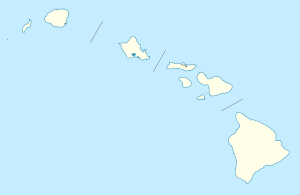Albert Spencer Wilcox Building
|
Albert Spencer Wilcox Building | |
|
Kauaʻi Museum | |
 | |
| Location |
4428 Rice Street Līhuʻe, Kauaʻi, Hawaii |
|---|---|
| Coordinates | 21°58′29″N 159°22′6″W / 21.97472°N 159.36833°WCoordinates: 21°58′29″N 159°22′6″W / 21.97472°N 159.36833°W |
| Area | 0.5 acres (0.20 ha) |
| Built | 1922 |
| Architect | Hart Wood |
| NRHP Reference # | 79000760[1] |
| Added to NRHP | May 31, 1979 |
The Albert Spencer Wilcox Building, was originally a library and then converted to the Kauaʻi Museum, which displays exhibits on the history of the island of Kauaʻi in Hawaii.
Library
The first library on the island of Kauaʻi was probably established by Reverend John Mortimer Lydgate in 1900 at his church in Līhuʻe. After moving to a temporary home in 1921, a permanent home was needed.[2] On February 3, 1922, Emma Kauikeolani Wilcox, widow of businessman and politician Albert Spencer Wilcox (1844–1919) offered US$75,000 for a public library on Kauaʻi.[3] In October 1922 architect Hart Wood was selected to design the building named in honor of Wilcox. Built with John Hansen as general contractor, it opened in 1924 to house the first public library on the island.[4]
Museum
In April 1954 a committee started raising funds for a museum to be built next to the library. Juliet Rice Wichman (1901–1987) was chair of the committee. A granddaughter of businessman and politician William Hyde Rice, she had married Frederick Warren Wichman after the death of her first husband Holbrook M. Goodale.[5][6] The new building was designed by architect Kenneth Roehrig and named for Rice.[4] Wichman became the museum's first director, and would later co-found the National Tropical Botanical Garden and donate land to become the Limahuli Garden and Preserve to the garden.[7] The first manager of the museum was Dora Jane Isenberg Cole (1917–1988), a second cousin of Wichman sharing great-grandfather William Harrison Rice (1813–1862) but Paul Isenberg (1837–1903) as her paternal grandfather.[8]
On December 3, 1960, the museum opened to the public in the Rice building. In 1969 the state of Hawaii built a new library building, and the Wilcox building was converted to house additional exhibits of the Kauaʻi Museum, opening in December 1970.
Preservation
The Wilcox building was listed as state historic site 30-11-9344 on February 17, 1979. It was added to the National Register of Historic Places listings in Hawaii on May 31, 1979 as site 79000760.[9] It is located at 4428 Rice Street, 21°58′29″N 159°22′6″W / 21.97472°N 159.36833°W in Līhuʻe.
Family tree
| Rice–Cooke family tree | ||||||||||||||||||||||||||||||||||||||||||||||||||||||||||||||||||||||||||||||||||||||||||||||||||||||||||||||||||||||||||||||||||||||||||||||||||||||||||||||||||||||||||||||||||||||||||||||||||||||||||||||||||||||||||||||||||||||||||||||||||||||||||||||||||||||||||||||||||||||||||||||||||||||||||||||||||||||||||||||||||||||||||||||||||||||||||||||||||||||||||||||||||||||||||||||||||||||||||||||||||||||||||||||||||||||||||||||||||||||||||||||||||
|---|---|---|---|---|---|---|---|---|---|---|---|---|---|---|---|---|---|---|---|---|---|---|---|---|---|---|---|---|---|---|---|---|---|---|---|---|---|---|---|---|---|---|---|---|---|---|---|---|---|---|---|---|---|---|---|---|---|---|---|---|---|---|---|---|---|---|---|---|---|---|---|---|---|---|---|---|---|---|---|---|---|---|---|---|---|---|---|---|---|---|---|---|---|---|---|---|---|---|---|---|---|---|---|---|---|---|---|---|---|---|---|---|---|---|---|---|---|---|---|---|---|---|---|---|---|---|---|---|---|---|---|---|---|---|---|---|---|---|---|---|---|---|---|---|---|---|---|---|---|---|---|---|---|---|---|---|---|---|---|---|---|---|---|---|---|---|---|---|---|---|---|---|---|---|---|---|---|---|---|---|---|---|---|---|---|---|---|---|---|---|---|---|---|---|---|---|---|---|---|---|---|---|---|---|---|---|---|---|---|---|---|---|---|---|---|---|---|---|---|---|---|---|---|---|---|---|---|---|---|---|---|---|---|---|---|---|---|---|---|---|---|---|---|---|---|---|---|---|---|---|---|---|---|---|---|---|---|---|---|---|---|---|---|---|---|---|---|---|---|---|---|---|---|---|---|---|---|---|---|---|---|---|---|---|---|---|---|---|---|---|---|---|---|---|---|---|---|---|---|---|---|---|---|---|---|---|---|---|---|---|---|---|---|---|---|---|---|---|---|---|---|---|---|---|---|---|---|---|---|---|---|---|---|---|---|---|---|---|---|---|---|---|---|---|---|---|---|---|---|---|---|---|---|---|---|---|---|---|---|---|---|---|---|---|---|---|---|---|---|---|---|---|---|---|---|---|---|---|---|---|---|---|---|---|---|---|---|---|---|---|---|---|---|---|---|---|---|---|---|---|---|---|---|---|---|---|---|---|---|---|---|---|---|---|---|---|---|---|---|---|---|---|---|---|---|---|---|---|---|---|---|---|---|---|---|---|---|---|---|---|---|---|---|---|---|---|---|---|---|---|
| ||||||||||||||||||||||||||||||||||||||||||||||||||||||||||||||||||||||||||||||||||||||||||||||||||||||||||||||||||||||||||||||||||||||||||||||||||||||||||||||||||||||||||||||||||||||||||||||||||||||||||||||||||||||||||||||||||||||||||||||||||||||||||||||||||||||||||||||||||||||||||||||||||||||||||||||||||||||||||||||||||||||||||||||||||||||||||||||||||||||||||||||||||||||||||||||||||||||||||||||||||||||||||||||||||||||||||||||||||||||||||||||||||
| Notes:
| ||||||||||||||||||||||||||||||||||||||||||||||||||||||||||||||||||||||||||||||||||||||||||||||||||||||||||||||||||||||||||||||||||||||||||||||||||||||||||||||||||||||||||||||||||||||||||||||||||||||||||||||||||||||||||||||||||||||||||||||||||||||||||||||||||||||||||||||||||||||||||||||||||||||||||||||||||||||||||||||||||||||||||||||||||||||||||||||||||||||||||||||||||||||||||||||||||||||||||||||||||||||||||||||||||||||||||||||||||||||||||||||||||
See also
- Albert Spencer Wilcox Beach House, Hanalei, Hawaii, also NRHP-listed
References
- ↑ Nathan Napoka (April 1979). "Kauaʻi Museum nomination form" (PDF). National Register of Historic Places. U.S. National Park Service. Retrieved September 18, 2010.
- ↑ Hank Soboleski (April 25, 2008). "Island History". The Garden Island. Retrieved September 23, 2010.
- ↑ Stormy Cozad (August 2008). Kauai. Arcadia Publishing. p. 115. ISBN 978-0-7385-5644-4.
- 1 2 "Kauaʻi Museum". official web site. Retrieved September 22, 2010.
- ↑ Marylou Bradley, ed. (2002). "Rice Family Papers 1838–1964" (PDF). Kauaʻi Historical Society. Retrieved September 28, 2010.
- ↑ Hawaiian Mission Children's Society (1922). Annual report. 70. pp. 47–48.
- ↑ "Limahuli Valley, a Living Legacy". Hawaii Stream Research Center web site. University of Hawaii. Retrieved September 23, 2010.
- ↑ Marylou Bradley; Carolyn Dettling (2010). "Finding Aid for Isenberg Collection" (PDF). Kaua’i Historical Society. Retrieved September 23, 2010.
- ↑ "National and State Register of Historic Places on Kaua'i" (PDF). Hawaii Historic Preservation Division. June 2009. Retrieved September 22, 2010.